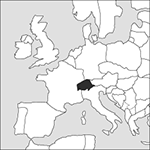
Source: MAPS IN MINUTES™ © RH Publications (1997)
Capital:
Berne
Area:
41,277 sq km (15,937 sq miles)
Population:
7,996,026 (2013 est)
Currency:
1 Swiss franc = 100 centimes
Religions:
Roman Catholic 38.2%; Protestant 26.9%; Muslim 4.9%
Ethnic Groups:
German 65.0%; French 18.0%; Italian 10.0%; Romansch 1.0%
Languages:
French, German, Italian, Romansch (all official); minority languages
International Organizations:
UN; OECD; EFTA; Council of Europe; OSCE; Euro-Atlantic Partnership Council; WTO
A country in central Europe, consisting of a Federation of 23 cantons; three cantons are subdivided making a total of 26 administrative units.
Physical
Switzerland is surrounded by France, Germany, Italy, and the tiny country of Liechtenstein. It is Europe’s loftiest country with the Alps stretching across the whole of its southern half. The rivers Rhône and Rhine rise here and form broad valleys. Below the forested mountain slopes, snow-covered all winter, the land is fertile and the summer temperature is warm. Northward the country stands on a hilly plateau which contains the Swiss Lakes and rises again in the north-west to the Jura Mountains.
Economy
Switzerland is prosperous, with one of the highest GDPs per capita in the world. Major exports include pharmaceuticals, machinery, chemicals, metals, watches, and foodstuffs. Tourism and international banking and insurance are important. Agriculture produces grains, fruit, vegetables, meat, and eggs.
History
Switzerland was occupied by the Celtic Helvetii in the 2nd century bc. Its position astride vital Alpine passes caused the area to be invaded by the Romans, Alemanni, Burgundians, and Franks before it came under the control of the Holy Roman Empire in the 11th century. In 1291 the cantons (Swiss confederacies) of Uri, Schwyz, and Unterwalden declared their independence of their Habsburg overlords, and the alliance for mutual defence was later joined by Lucerne, Zürich, and Bern. During the 15th century this Swiss Confederation continued to expand, and it fought successfully against Burgundy, France, and the Holy Roman Empire, creating a great demand for its soldiers as mercenaries. During the Reformation and Counter-Reformation, its political stability was undermined by civil warfare, but in 1648 the Habsburgs acknowledged its independence in the Treaty of Westphalia.
In 1798 French Revolutionary armies entered the country and established the Helvetic Republic. But at the Congress of Vienna (1815) Swiss control was restored and the European powers guaranteed the confederation’s neutrality. In 1847 a separate Roman Catholic league within the federation, the Sonderbund, was formed after radicals took power in one of the cantons. After a brief civil war, peace and stability were restored by the new, democratic, federal constitution of 1848. During World War I the country maintained its neutrality despite the contradictory affections of the French and German sections of its population. In World War II the Swiss again preserved their armed neutrality, and have continued since then to enjoy a high level of economic prosperity. In 1979 the 22 cantons of the confederation were joined by the new Canton of Jura. Women were not allowed to vote on a federal basis until 1971, and suffrage remains restricted in some cantons. Because of its long tradition of neutrality, the International Red Cross and many UN agencies are based in Switzerland, as were the League of Nations. In 1992 it rejected by referendum membership of the European Economic Area. In 1998, Ruth Dreifuss became its first female President. In that year, bowing to international pressure, the Swiss banks released $1.25 billion to the families of Jews murdered by the Germans in the Holocaust—money deposited by the victims before or during the war. In 2002 Switzerland joined the UN and in 2008 it joined the Schengen Area. It has increased banking transparency, and from 2011 to 2015 it pegged the Swiss franc to the euro. The right-wing Swiss People’s Party is increasing its share of the vote and was behind a referendum vote in 2014 to restrict migration from EU countries. After protracted discussions with the EU, the Swiss government implemented a much watered-down version of the proposal in 2016.
- sulphonate
- sulphonation
- sulphonic acids
- sulphonium compounds
- sulpho-salts
- sulphoxides
- sulphur
- sulphur bacteria
- sulphur bridge
- sulphur cycle
- sulphur dichloride
- sulphur dichloride dioxide
- sulphur dichloride oxide
- sulphur dioxide
- sulphuretted hydrogen
- sulphuric acid
- sulphuric(IV) acid
- sulphur(IV) oxide
- sulphur monochloride
- sulphur mustard
- sulphur, native
- sulphurous acid
- sulphur trioxide
- sulphur(VI) oxide
- sulphuryl chloride